 | |
 Train travelling through the Taieri Gorge Train travelling through the Taieri Gorge | |
| Overview | |
|---|---|
| Headquarters | Dunedin, New Zealand |
| Locale | Eastern Otago, New Zealand |
| Dates of operation | 1991 (1991)– |
| Predecessor | New Zealand Railways Corporation |
| Technical | |
| Track gauge | 1,067 mm (3 ft 6 in) |
| Other | |
| Website | www |
Dunedin Railways (formerly the Taieri Gorge Railway) is the trading name of Dunedin Railways Limited, an operator of a railway line and tourist trains based at Dunedin Railway Station in the South Island of New Zealand. The company is a council-controlled trading organisation wholly owned by Dunedin City Council through its holding company Dunedin City Holdings Limited.
History
Formation

The Otago Excursion Train Trust was formed in 1978 to operate excursions on the Otago Central Railway line, running its first train in October 1979. The services grew in popularity and the Trust realised by the 1980s that it had great tourist potential. New carriages were acquired with the "Taieri Gorge Limited" launching in February 1987.
On 19 December 1989, the New Zealand Railways Corporation announced the closure of the Otago Central railway line beyond Taieri owing to a lack of freight traffic following the completion of the Clyde Dam. Dunedin City Council then stepped in, purchasing the line as far as Middlemarch and five locomotives, which were then leased by the Trust to run its trains. The Trust continued to operate the Taieri Gorge Limited, now with its own locomotives (DJ class locomotives withdrawn by NZR in the same year), but needed a further NZ$1 million to fund its operations. A community appeal in 1990 raised NZ$1.2 million. The line beyond Middlemarch on the Otago Central Branch was lifted during 1991, and the trackbed handed over to the Department of Conservation in 1993. It is now the Otago Central Rail Trail, a major cycling tourist attraction in the area.
Local Authority Trading Enterprise
On 8 March 1995, the Dunedin City Council (through its holding company Dunedin City Holdings Limited) and the Trust incorporated a new company, Taieri Gorge Railway Limited. Dunedin City Holdings was a majority shareholder (72.03%) and the Trust held the balance of the shares (27.97%). The company operated as a Council-controlled organisation (formerly known as a Local-authority trading enterprise) under Part 5 of the Local Government Act 2002. This was due to the need to raise more capital to finance the expansion of the Trusts operation. Dunedin City Council then sold the railway line to the new company, and the Trust sold its locomotives, carriages and other assets to the new company. The company is governed according to its constitution by a board of directors comprising six people. Two of these people were selected by Dunedin City Holdings Limited, two by the Otago Excursion Train Trust and two jointly by both shareholding parties. On 1 December 2017, the company changed its name to Dunedin Railways Limited.
Taieri Gorge Limited
Main article: Otago Central RailwayThe Taieri Gorge Limited is New Zealand's longest tourist railway and stretches along the former Otago Central Railway from the 4 km peg on the Taieri Branch, 18 km west of Dunedin, to Middlemarch, a distance of 60 kilometres (37 mi). Between Dunedin and the start of the line, its trains operate on KiwiRail's Main South Line via a running rights agreement.
The line travels along the banks of the Taieri River, through numerous tunnels and along the Taieri Gorge to the Strath Taieri. It crosses a dozen viaducts and passes through ten tunnels.
At Wingatui railway station, the original building and signal box from 1914 have been restored. After the line passes through the 437 metres (1,434 ft) long Salisbury Tunnel, the longest on the line, it crosses Mullocky Gully over the 197 metres (646 ft) long Wingatui Viaduct, the largest wrought iron structure in New Zealand since it was built in 1887. The 47 m tall viaduct's riveted truss structure rests on seven concrete and masonry piers.
Shortly after the Wingatui Viaduct, the route emerges from Mullocky Gully to join Taieri Gorge, and from then on follows that gorge above Taieri River to just east of Pukerangi. On the way the line passes former stations Parera, Mount Allen, Little Mount Allen, and Christmas Creek, crossing two curved viaducts at the latter two locations. Hindon, still operating as a crossing station, is typically one of the stopping points on the trip. Just before the station, the railway tracks share a combined road-rail bridge with Hindon Road.
Another stopping point for photo opportunities is the Deep Stream viaduct. Here the line slowly starts to climb higher and out of the gorge, passing over the Flat Stream viaduct, and "The Notches", a section of short bridges and cuttings through several rocky outcrops, on its way to Pukerangi. Between Pukerangi and Middlemarch, the railway only once more comes close to the Taieri River, where it crosses Sutton Creek over another combined road-rail bridge.
Dunedin Railways currently operates on a reduced schedule. The Inlander runs through the Taieri Gorge to Hindon, The Seasider runs up the coast through Waitati to Seacliff, and The Victorian is an all-day trip to the North Otago town of Oamaru. Special services also run, including the Christmas Inlander in December and the addition of Quiz Trains in 2023. 2024 saw the addition of The Stargazer, a trip to Hindon for an evening of star gazing hosted by the Dunedin Astronomical Society.

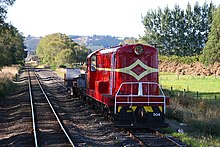
Seasider and Dunedin Silver Fern
Dunedin Railways also operates the Seasider tourist train along the coast to Waitati, north of Dunedin. Following the withdrawal of the Southerner by Tranz Scenic in 2002, it is the only passenger train on the Main South Line.
In 2012, Dunedin Railways leased one of the Silver Fern class railcars from KiwiRail for use on the same route as the Seasider.
Rebranded Dunedin Railways
On 23 October 2014, the Taieri Gorge Railway announced that it would be changing its name to Dunedin Railways. For 35 years, the Taieri Gorge Railway and the Otago Excursion Train Trust had taken tourists on scenic rail excursions up the Taieri Gorge to Middlemarch and more recently up the coast, north of Dunedin on the Seasider. The reason for the change was so that tourists can link the train trips to Dunedin and it makes it much clearer what the railway is. AO 77 was the first carriage to be repainted into their new blue livery with their name on the sides in October 2014. This was followed by A 3022 and AG 239. In September 2015, A 1695 was repainted into their yellow version of livery.
Mothballing
On 20 April 2020, the company announced that due to the COVID-19 pandemic in New Zealand, it mothballed its track and equipment. The company said up to 80% of its revenue came from international tourists. The mothballing could affect up to 51 jobs.
Reactivation and restructure
Following the decision to mothball Dunedin Railways, the Otago Excursion Train Trust sold its shares in the company to the council in April 2020.
In May 2021, Dunedin City Council agreed to keep the Taieri Gorge line as far as Hindon in operation, as well as services on KiwiRail's railway lines. In November 2021, the council agreed to extend support through to 2024. In 2023, the council decided to reactivate the Hindon-Middlemarch section as well.
Financial performance
In the financial year to June 2017, Dunedin Railways had revenues of NZ$6.578m and expenses of NZ$6.387m, and turned a profit of NZ$137,000. Following the COVID-19 pandemic of 2021, Dunedin Railways was losing NZ$1.5 million per annum.
Locomotives and railcars
The railway owns seven former New Zealand Railways D class locomotives, four of which are currently operational and certified for mainline operation. They are painted in a variant of the modified New Zealand Railways scheme carried by the class in the 1980s, where the low nose sides are painted blue instead of yellow and grey cab front. Two locomotives are in an operational condition, but are not currently certified for mainline use; a seventh, DJ3021 (ex-D 1202), is being stored, pending future restoration after it was purchased from its former home at Ranfurly station where it was a static display. An eighth, DJ3044 (D 1204) was acquired from Mainline Steam in 2012 as a source of spare parts and has been dismantled. Both were painted in the modified blue scheme and were purchased in a withdrawn condition.
TGR also operates one D class locomotive, D 504 (TMS DE1337). This locomotive was acquired from Otago Polytechnic (who had acquired it from New Zealand Railways Corporation) in the early 1990s and is not mainline certified, instead of being based at the TGR works depot at the 4 km peg. It previously carried a modified International Orange scheme but was repainted in 2006 to its original livery of Carnation Red with the addition of "wasp stripes" on the headstocks as it would have carried in the 1970s.
In 2013, Dunedin Railways leased Silver Fern railcar RM24 from KiwiRail and operated this on trips between Dunedin and Waitati. The railcar was returned to KiwiRail in 2019.
Dunedin Railways formerly operated a shunting locomotive, T 111 at their Dunedin depot as their resident shunting locomotive. This locomotive was obtained by the Otago Excursion Train Trust in 2009 from enthusiast Reid McNaught, who had leased the locomotive to Dunedin Railways since 2006. It was sold to the Canterbury Railway Society in July 2015.
Carriages
47' 6" wooden body carriages
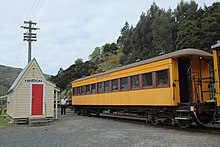
All trains as of January 2017 include some of Dunedin Railways five former New Zealand Railways 47" 6' foot wooden-clad carriages. These cars are known as "Scarrett'" heritage carriages and were built between 1912 and 1923 with open platform ends, gangways and 37 seats. Dunedin Railways has started retiring these carriages largely to provide bogies for their 56-foot carriage stock, which did not have their own bogies when they were purchased. Two of the 47-foot cars have been sold, while two were scrapped circa 1978. One carriage, A 1254, is owned by the Ocean Beach Railway (OBR) and is leased to Dunedin Railways. This carriage will be returned to the OBR at the conclusion of its lease.
50-foot carriages
Dunedin Railways has currently three steel-clad and one wood-clad NZR 50-foot carriages, formerly used on Dunedin suburban trains and express passenger trains. The steel-clads have 30-37 seats, enclosed vestibules and covered gangways and were built by New Zealand Railways Department in 1931–40. One of these is an AL class car-van with a small luggage compartment at one end while the other two are A class carriages. Steel-clad cars, A class 50159 and 50223 were sold to the Weka Pass Railway in 2008 and AL 50090 was sold to the Midland Rail Heritage Trust in 2013. The wood-clad carriages are A 1327, built in 1913, with open vestibules and non-covered gangways.
Jungle Gym panorama carriages
Dunedin Railways has three all-steel air-conditioned panorama carriages with open platform ends and open gangways, known locally as "Jungle Gyms" due to the nature of their framework when under construction. These were designed and built by the OETT in 1987–92, with a "very distinctive shape to fit the tunnels". Two of these carriages were built on Z class "roadsider" freight van underframes while the third was built on the underframe of guard's van F 529.
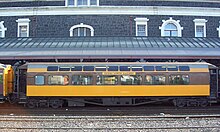
56-foot carriages
In September 2007, the Taieri Gorge Railway announced that it had purchased 12 NZR 56-foot carriages formerly used on the Wairarapa Connection. The first of these, A 2325, was prepared at a cost of $45,000 and was ready in September 2008. The company anticipated having three carriages in service by the end of 2008, and all 12 by 2013. The upgrade included new seating, carpets, toilets and external paint. The railway intends to refurbish three carriages each year. As of December 2015, only five out of the twelve carriages have been restored. Two of these carriages have since been disposed of.
In 2012, panoramic window car AO 77 was leased from KiwiRail. It has since been repainted in Dunedin Railways' blue livery and is now under their ownership. Privately owned A 3022 is leased from its owners since 2013. In 2018, Dunedin Railways purchased six big-window AO/ASO class carriages from KiwiRail. Two of these have since been converted to all-steel framing and reclassified as ADR.
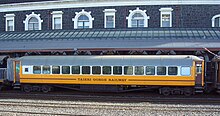
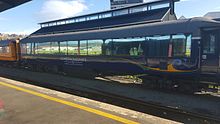
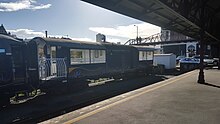
Freight haulage
In the early 2000s, the TGR investigated the possibility of introducing log haulage between Mount Allan and Port Chalmers at the end of the Port Chalmers Branch. However, on 12 June 2007, it was announced that a cost difference of NZ$5 million existed between road and rail haulage in favour of road, and potential government subsidies were insufficient to close the gap. The announcement was met with disappointment by the Dunedin City Council, which favourably viewed the rail option as it was more environmentally friendly and would have reduced traffic congestion.
It has since been worked out that with extra damage caused by the logging trucks on the Mosgiel to Port Chalmers road that it would have been cheaper to perform the operation by rail, but despite pleas by the local council, Wenita, the relevant company, said it had invested too much in the road option to change its plans.
The route's loading gauge restricts the maximum size of rolling stock that can operate on the railway; some freight wagons cannot use the line.
See also
References
Citations
- "Policies" (PDF). Dunedin City Council Community Plan 2009/10 – 2018/19. Vol. 2, section 4. Dunedin City Council. 2009. p. 291. Archived from the original (PDF) on 14 May 2010. Retrieved 24 March 2010.
- ^ "Our Story". Dunedin Railways. Archived from the original on 24 September 2014. Retrieved 3 December 2014.
- ^ "Otago Central Railway Closure". New Zealand Railway Observer. 46 (4). New Zealand Railway and Locomotive Society: 165. Summer 1989–90. ISSN 0028-8624.
- ^ "Companies Office - Taieri Gorge Railway Limited". Retrieved 6 November 2014.
- "Dunedin Railways Limited". Companies Office. Retrieved 15 March 2019.
- Taieri Gorge Railway - 2006-2007 Times & Destinations - Leaflet by Taieri Gorge Railway Limited, March 2006
- "Wingatui Station". Rail Heritage Trust of New Zealand. Archived from the original on 7 April 2014. Retrieved 9 April 2014.
- "Along the way - Taieri Gorge Railway". Taieri Gorge Limited. Archived from the original on 13 April 2014. Retrieved 9 April 2014.
- Railways, Dunedin. "Dunedin Railways". Dunedin Railways. Retrieved 30 July 2023.
- Railways, Dunedin. "The Inlander". Dunedin Railways. Retrieved 30 July 2023.
- Railways, Dunedin. "The Seasider". Dunedin Railways. Retrieved 30 July 2023.
- Railways, Dunedin. "The Victorian". Dunedin Railways. Retrieved 30 July 2023.
- Railways, Dunedin. "The Christmas Inlander". Dunedin Railways. Retrieved 30 July 2023.
- Railways, Dunedin. "The Stargazer". Dunedin Railways. Retrieved 2 July 2024.
- "ODT Report". Retrieved 2 July 2024.
- "New Look for Railway Operation". Otago Daily Times. 23 October 2014. Archived from the original on 4 December 2014. Retrieved 2 December 2014.
- ^ Dunedin Railways (20 April 2020). "Statement on the future of Dunedin Railways". Scoop.co.nz. Archived from the original on 24 April 2020. Retrieved 20 April 2020.
- "Taieri Gorge track to be mothballed, 51 jobs likely to go". Otago Daily Times. 20 April 2020. Archived from the original on 20 April 2020. Retrieved 20 April 2020.
- "Otago Excursion Train Trust". Archived from the original on 7 September 2021. Retrieved 8 September 2021.
...was the founder of the Taieri Gorge Railway and was the joint owner of the company with the Dunedin City Council until April 2020, when the company was put into "mothballs" by the DCC.
- Grant Miller (10 April 2021). "What lies ahead for Dunedin Railways". Otago Daily Times. Archived from the original on 7 September 2021. Retrieved 8 September 2021.
- ^ "Taieri Gorge line to stay open as far as Hindon". Otago Daily Times. 1 June 2021. Archived from the original on 3 June 2021. Retrieved 3 June 2021.
- "Gorge line stays: Councillors keep faith with Dunedin Railways". Otago Daily Times. 22 November 2021. Archived from the original on 23 November 2021. Retrieved 24 November 2021.
- "Council looks to retain Taieri Gorge route". Otago Daily Times. 4 February 2023. Archived from the original on 4 February 2023. Retrieved 4 February 2023.
- "Dunedin Railways Interim Report to 31 December 2017" (PDF). Dunedin City Council. 31 December 2017. Archived (PDF) from the original on 27 December 2021. Retrieved 15 March 2019.
- ^ 'technical information' Archived 16 May 2009 at the Wayback Machine on TGR website, retrieved 2009-05-10
- Stevens, Sam (13 September 2008). "New Taieri Gorge carriage on display". Otago Daily Times. Archived from the original on 14 September 2008. Retrieved 14 September 2008.
- New Zealand Railway Observer, December 2008-January 2009
- Simon Hartley, "Costs Rule Out Rail in the Long Run" Archived 28 September 2007 at the Wayback Machine, Otago Daily Times, 12 June 2007.
- "Promoting sustainability in New Zealand's rail system" (PDF). NZ Transport Agency. Archived (PDF) from the original on 29 January 2019. Retrieved 12 May 2020.
Bibliography
- Bowden, David. Great Railway Journeys in Australia and New Zealand. Oxford, England: John Beaufoy Publishing. pp. 152–155. ISBN 978-1-909612-94-5.
- Cunningham, Gerald (2011). The Taieri Gorge Railway: Guide to the Taieri Gorge and Seasider Rail Trips. Albany, Auckland: David Bateman Ltd. ISBN 978-1-86953-815-6.
- Dangerfield, J. A.; Emerson, G. W. (2010). Over The Garden Wall: The Story of the Otago Central Railway (4th ed.). Dunedin: The Otago Railway & Locomotive Society Incorporated. ISBN 978-0-473-17363-0. (soft-bound); 978-0-473-17362-3 (hard-bound).
- Hurst, Tony (2008). The Otago Central Railway: A tribute (5th expanded ed.). Wellington: Transpress. ISBN 978-1-877418-05-1.
External links
- Dunedin Railways
- Taieri Gorge Railway Photo gallery
- Otago Central Branch Railway
- Taieri Gorge Railway - New Zealand
| Rail operators of New Zealand | |
|---|---|
| Current operators | |
| Former operators | |
45°52′31″S 170°30′32″E / 45.87528°S 170.50889°E / -45.87528; 170.50889
Categories: